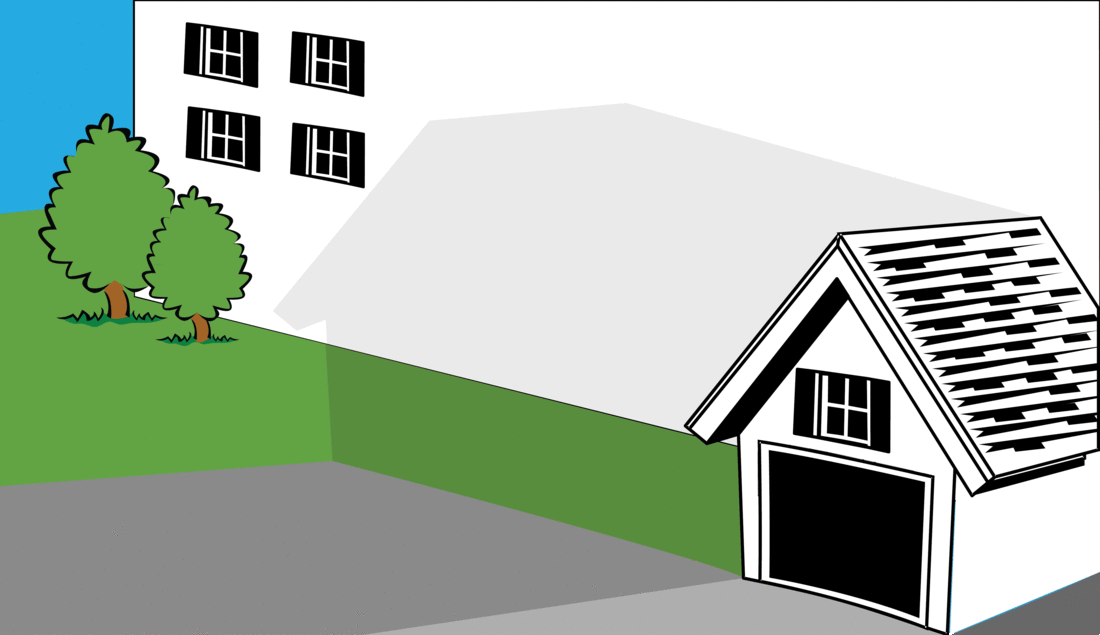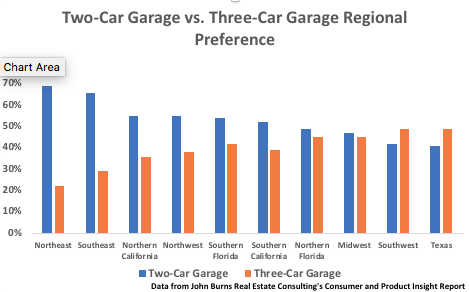This story was originally published in Builder.

Although it’s predicted that the popularity of ride-sharing services and the rise of self-driving vehicles will soon impact the country’s demand for cars, Americans are as dependent as ever on their personal vehicles, and this means they still need a place to park them.
With an average of 1.950 cars per household, Americans’ car ownership rate has fallen only slightly from a high of 2.050 in 2006, according to a University of Michigan study. Americans’ love affair with their automobiles has implications in new home building, where there is an increasing demand for garages.
“I’d say people at least want one-car space, with the majority wanting two or more,” says Jenni Lantz, DesignLens manager for John Burns Real Estate Consulting. The firm’s Consumer and Product Insight Reports, a survey of around 24,000 new home shoppers nationwide, found that no homeowners surveyed wanted a potential home without a garage. “I don’t think we’re quite in the no-car garage space yet,” she says.
Data from the U.S. Census Bureau and the National Association of Home Builders (NAHB) disputes any idea that garages might be declining in popularity. Of the 795,000 single-family homes completed in 2017, 65% had two-car garages and 6% had one-car garages, while only 7% had no garages.
The percentage of homes built that have no garages has declined over the past decade, according to U.S. Census numbers. The amount of single-family homes completed with no garages was 12% in 2008 and peaked at 13% in 2010. Since then, the amount of homes built with no garages has steadily declined, while homes built with two-car garages have gained in percentage terms during the same period.
Mikaela Sharp, a John Burns consultant, said 92% of people shopping for a detached new-construction home want a two- or three-car garage. Around 70% of new home shoppers are couples with two adults, and a two-car garage provides the option for each person to store their car, Sharp said. Households with only one adult or a single car may still favor two-car garages for the additional storage provided by the larger garage. Around 53% of those surveyed in the Consumer and Products Insights Report indicated wanting a two-car garage in their future home.

Homes with two-car garages have accounted for over 60% of single-family homes built since 2000, according to the U.S. Census, and the 65% of homes completed with a two-car garage in 2017 is the highest share of the market two-car garages have occupied since 1993. Among single-family homes purchased in 2017, 70% had two-car garages.
“I’d say the majority of homes that come out tend to come out with a two-car garage,” Lantz said. “The standard side-by-side tends to be the most traditional, while the tandem [two-car garage] tends to get a bit more pushback.”
Rumors of autonomous cars and ride-sharing services like Uber and Lyft disrupting the popularity of garages are contrasted by data suggesting garages are more popular than ever. Lantz said while there are some discussions among architects about what the future will look like for garages, the feature is too ingrained in the American lifestyle to be abandoned completely.
In an indication of the garage’s staying power even if ride-sharing use skyrockets: a 2015 survey from Gladiator GarageWorks found 25% of homeowners had garages so cluttered they could not even fit a single car, regardless of size, illustrating the reliance on the garage as a storage space for homeowners.
Not surprisingly, as the size of a home increases, the number of garages in the home goes up. For example, the NAHB reports the share of completed homes with one-car garages is 13.9% for homes smaller than 1,200 square feet, but that proportion drops to 3% for homes between 2,400 and 2,999 square feet. Conversely, two-car garages are present in 15.2% of homes smaller than 1,200 square feet, but that proportion rises to 78.3% for homes between 2,000 and 2,399 square feet.
The trend of homes built with two-car garages or more have steadily increased as the average size of homes built have increased, to it’s current all-time high of 2,687 square feet. Homes with three-car or larger garages risen steadily over the past two decades. Twenty percent of homes completed in 2017 had three-car garages or larger garages. Completed homes with three-car or larger garages accounted for 24% of the market in 2015 and has recorded a value above 20% in each year since 2013.
There appears to be a tipping point for some buyers: While three-car garages are generally more popular in regions where home prices are more favorable, Lantz says many homeowners surveyed would be willing to give up additional space in garages to pay a less for a home.

The popularity of three-car garages fluctuates based on regional markets. Data from the NAHB indicated that the West North Central census region, containing states such as Kansas, Missouri, Minnesota, and the Dakotas, saw garages large enough for three or more cars in 50% of all new homes as recently as 2016. The Mountain region and the East North Central regions also reported three-car or larger garages in over 35% of all homes purchased. The New England, Mid-Atlantic, and South Atlantic regions, however, reported three-car or larger garages in less than 12% of homes purchased. John Burns found that in the Southwest, and Texas in particular, three-car garages are more popular than two-car garages, with 49% of potential homeowners favoring a home with a three-car garage while only 41% favor a home with a two-car garage.
When it comes to one-car garages, the highest share in the U.S. is the Mid-Atlantic and New England regions, according to the NAHB, areas of the country where land is expensive and lots are small. The Northeast and Southeast region have the highest preference for two-car garages, according to John Burns, with two-thirds of detached home shoppers searching for two-car garages.
The size of two- and three-car garages may also be increasing to accommodate the desire for more storage in garage spaces. A standard two-car garage is about 20 feet wide with a depth of 22 to 24 feet, while a standard three-car garage is about 30 feet wide and 24 feet deep. However, a growing number of two-car garages are being built with dimensions of 24 feet by 24 feet, both to accommodate larger vehicles and to allow homeowners more storage space.
“I’m starting to see more people build in the oversized garage,” Lantz said. “So, it’s still the 20-foot-wide door [for a two-car garage], but you’re getting more depth to it. They’re building in storage space.”
Among consumers surveyed by John Burns Real Estate Consulting, storage ranked highly in terms of what homeowners wanted to use their garage space for. Sharp said 45% of potential homeowners will likely purchase storage units to put in their garages. Garage cabinet systems can be installed with similar 24-inch depths as kitchen cabinets to facilitate greater storage space.
While the majority of consumers want larger garages, they don’t necessarily want them to be visible from the street. Lantz says that many three- and four-car garages are presented in visually different ways to make homes appear as if they only have a two-car garage.
“I’m seeing a lot more attention to street visibility for garages,” she says. “Now, especially if homes have a third or fourth car garage, you’ll see a two-car garage from the street and they’re hiding the other one.”
This story was originally published in Builder.


















